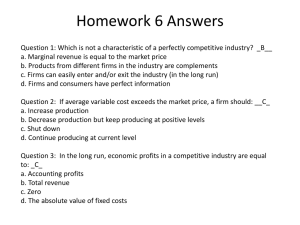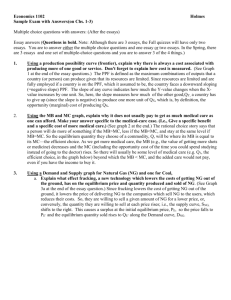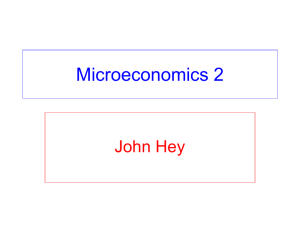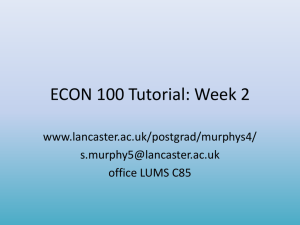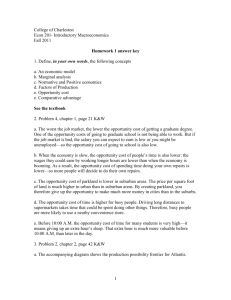Econ 201 Exam 1: Economics Principles & Applications
advertisement
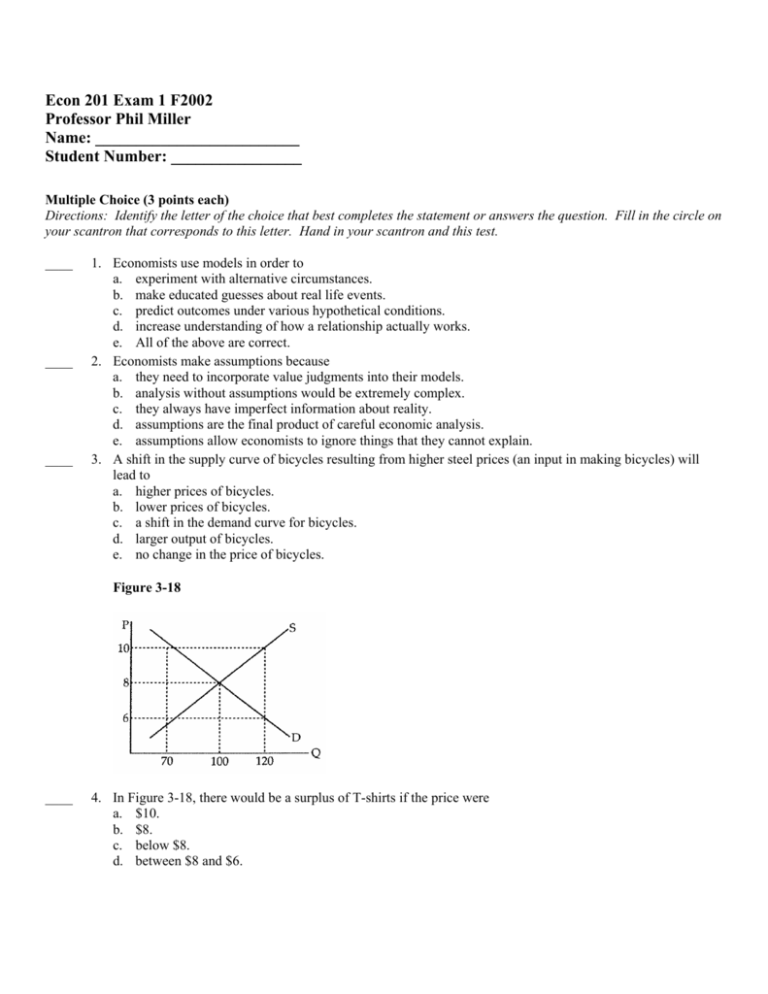
Econ 201 Exam 1 F2002 Professor Phil Miller Name: _________________________ Student Number: ________________ Multiple Choice (3 points each) Directions: Identify the letter of the choice that best completes the statement or answers the question. Fill in the circle on your scantron that corresponds to this letter. Hand in your scantron and this test. ____ ____ ____ 1. Economists use models in order to a. experiment with alternative circumstances. b. make educated guesses about real life events. c. predict outcomes under various hypothetical conditions. d. increase understanding of how a relationship actually works. e. All of the above are correct. 2. Economists make assumptions because a. they need to incorporate value judgments into their models. b. analysis without assumptions would be extremely complex. c. they always have imperfect information about reality. d. assumptions are the final product of careful economic analysis. e. assumptions allow economists to ignore things that they cannot explain. 3. A shift in the supply curve of bicycles resulting from higher steel prices (an input in making bicycles) will lead to a. higher prices of bicycles. b. lower prices of bicycles. c. a shift in the demand curve for bicycles. d. larger output of bicycles. e. no change in the price of bicycles. Figure 3-18 ____ 4. In Figure 3-18, there would be a surplus of T-shirts if the price were a. $10. b. $8. c. below $8. d. between $8 and $6. ____ ____ ____ ____ ____ ____ ____ ____ 5. In late 1995 and early 1996, the Federal Reserve System reduced interest rates, the price which borrowers pay. As a result, economists expected the quantity of money demanded to a. increase. b. decrease. c. not change. d. not change, although the demand schedule itself will shift outward. 6. If the price of a good is below the equilibrium price, a. suppliers will find inventories building; they will cut output and raise prices. b. suppliers will find inventories being depleted. They will increase production and raise prices. c. the demand curve will shift down until an equilibrium is established at the existing price. d. the supply curve will shift up until an equilibrium is established at the existing price. 7. List the three coordination decisions made by every economy. a. Where? When? How? b. How? What? To whom? c. Why? Where? What? d. When? To Whom? Where? 8. According to the low-hanging fruit principle, the cost of producing a good increases as more of it is produced. Therefore, we expect that firms will produce more if a. the price increases. b. the price decreases. c. the opportunity cost is greater than the price. d. government asks firms to produce more. e. the income of buyers increases. 9. The demand curve for a good connects points describing how much consumers a. actually bought at different prices during a particular period. b. actually bought at different prices in different periods. c. would have been willing and able to buy at different prices during a particular period. d. would have been willing and able to buy at different prices in different periods. 10. The price for labor is the wage rate. What happens to the demand for labor if wages increase? a. It increases. b. It decreases. c. It does not change. d. Uncertain-economic theory has no answer to this question. 11. Equilibrium in a market is a. a situation in which there are no inherent forces that produce change. b. is only ensured by government intervention. c. the best price and quantity that can exist in a market. d. The fairest price and quantity traded that can exist in the market. 12. When GM advertises its cars, the company is trying to cause a a. rightward shift in the supply. b. rightward shift in the demand. c. leftward shift in the supply. d. leftward shift in the demand. ____ 13. An upward-sloping supply curve shows that a. buyers are willing to pay more for a scarce product. b. suppliers are willing to increase production of their goods if they can receive higher prices for them. c. buyers are unaffected by sellers' costs of production. d. the price of a product is not influenced by the price buyers are willing to pay. ____ 14. According to the principle of comparative advantage, a doctor who is also a talented auto mechanic should a. get a part-time job at a gas station. b. always do her own auto repairs and those of her neighbors. c. sometimes hire a professional mechanic to repair her car. d. only repair the cars of other doctors. ____ 15. Which of the following is a normative statement? a. George W. Bush is the president. b. The quantity demanded is inversely-related to the price. c. The minimum wage should be replaced with a "Living Wage". d. Minnesota is located north of Iowa. ____ 16. Why does quantity demanded decrease when price increases? a. People choose to reduce consumption of the item. b. People "drop out" of the market for the item. c. People find substitutes for the item. d. All of the above are correct. ____ 17. The imposition of price ceilings on a market often results in a. an increase in investment in the industry. b. a persistent surplus in the market. c. the diversion of income toward black-market suppliers. d. lower prices being offered on the black market. ____ 18. At an equilibrium price, quantity demanded a. exceeds quantity supplied. b. equals quantity supplied. c. is less than quantity supplied. d. Any of the above is possible. ____ 19. If oranges and grapefruit are close substitutes, an increase in the price of oranges will shift the demand curve of a. both products to the right. b. both products to the left. c. grapefruit to the right. d. oranges to the left. ____ 20. If a person makes a choice consistent with obtaining particular goal, she is said to be: a. all else equal b. rational c. self-interested d. antiquated ____ 21. Which of the following is an example of a price floor? a. rent controls b. maximum prices for gasoline c. usury laws that set maximum interest rates d. the minimum wage ____ 22. If price rises, what happens to supply for a product? a. It increases. b. It decreases. c. It does not change. d. Uncertain-economic theory has no answer to this question. ____ 23. When used in a professional or technical sense, the law of supply and demand refers to a. some vague influences on economic affairs. b. the fact that prices go up when commodities are scarce. c. the market forces that show how prices and quantities are determined. d. the controls that regulate the amount of scarce goods that each consumer can purchase. ____ 24. Suppose that in a free market 2,000 patients purchase an operation to receive an artificial heart at a price of $500,000 per operation. Without the heart, each patient will die. The government decides this price is too high and imposes a maximum price of $200,000. Everything else equal, a. more patients will now die. b. fewer patients will now die. c. more patients will now die only if the demand curve is vertical. d. more patients will now die only if the demand curve is horizontal. ____ 25. Lines, ration coupons, and black markets are symptoms of a a. price floor. b. price ceiling. c. free market. d. barter economy. Short Answer. Directions: Answer each question in the space provided below the question. 26. (7 points total) The state of Missouri is deciding whether to partially pay for a new stadium in downtown St. Louis for the St. Louis Cardinals. Suppose that if the state decides to partially pay for the new stadium, it will pay $100 million. Suppose that the next-best alternative is to take the $100 million and resurface the state's interstate system, currently one of the worst-maintained interstate systems in the nation. If it resurfaces the interstates, many trucking companies and other drivers that currently bypass the state in search of better roads will now drive through the state. Suppose that resurfacing the interstate system would bring a total of $200 million in new economic activity that otherwise would not take place. a. (2 points) What are Missouri's explicit costs of partially paying for the stadium? b. (2 points) What are Missouri's implicit costs of partially paying for the stadium? c. (3 points) What are Missouri's opportunity costs of partially paying for the stadium? 27. (9 points total) Consider the following table to answer this question Alex Jared Bushels of Output per Week Wheat 3 1 Barley 4 2 a. (2 points) Who has the absolute advantage in each of the goods? b. (3 points) Who has the comparative advantage in each of the goods? Justify your answer. c. (4 points) Suppose Alex and Jared are negotiating and are deciding if a trading ratio of 3 bushels of wheat for 5 bushels of barley is acceptable. Is this a trading ratio that both Alex and Jared could agree upon? If so, what are the gains from trade (in terms of bushels received) from this agreement? 28. (9 points total) Use the demand and supply diagram above to answer the following questions. a. (3 points) What is the reservation price of consumers at a quantity of 50 units? b. (3 points) Is there a shortage or a surplus at a price of $5? Calculate the size of the shortage or the surplus at a price of $5. c. (3 points) Suppose the market is currently in equilibrium. If a price ceiling of $15 is imposed in this market, what will happen to the price charged and the quantity traded in this market? Econ 201 Exam 1 F2002 Answer Section MULTIPLE CHOICE 1. 2. 3. 4. 5. 6. 7. 8. 9. 10. 11. 12. 13. 14. 15. 16. 17. 18. 19. 20. 21. 22. 23. 24. 25. E B A A A B B A C C A B B C C D C B C B D C C A B ESSAY 26. a. There are no explicit costs because the $100 million will be spent regardless of which alternative is chosen. b. $200 million - essentially the forgone economic activity that occurs as truckers bypass Missouri. c. $200 million. 27. a. Alex. b. Alex has the comparative advantage in wheat 4/3 < 2, Jared has it in barley (1/2 < 3/4). c. Yes, this is a trading ratio that each can agree to. Alex gets 1 bushel of barley and Jared gets ½ bushel of wheat from this proposal. 28. a. $15 b. There is a shortage of 100 units c. Nothing will happen to either price or quantity because the price ceiling is set above the equilibrium price.




